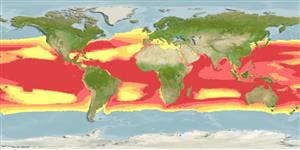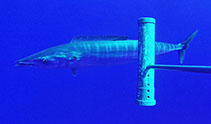Acanthocybium solandri (Cuvier, 1832)
Wahoo
Add your observation in Fish Watcher
| Native range | All suitable habitat | Point map | Year 2050 |

|
| This map was computer-generated and has not yet been reviewed. |
| Acanthocybium solandri AquaMaps Data sources: GBIF OBIS |
Upload your photos and videos
Pictures | Videos | Stamps, coins, misc. | Google imageAcanthocybium solandri
Picture by University of Western Australia (UWA)
Pictures | Videos | Stamps, coins, misc. | Google imageAcanthocybium solandri
Picture by University of Western Australia (UWA)
India country information
Common names:
Ayakkura, Digu-mas, Oria Neemeen
Occurrence: native
Salinity: marine
Abundance: | Ref:
Importance: | Ref:
Aquaculture: | Ref:
Regulations: | Ref:
Uses: no uses
Comments:
National Checklist:
Country Information: https://www.cia.gov/library/publications/resources/the-world-factbook/geos/in.html
National Fisheries Authority:
Occurrences: Occurrences Point map
Main Ref: Collette, B.B. and C.E. Nauen, 1983
National Database:
Occurrence: native
Salinity: marine
Abundance: | Ref:
Importance: | Ref:
Aquaculture: | Ref:
Regulations: | Ref:
Uses: no uses
Comments:
National Checklist:
Country Information: https://www.cia.gov/library/publications/resources/the-world-factbook/geos/in.html
National Fisheries Authority:
Occurrences: Occurrences Point map
Main Ref: Collette, B.B. and C.E. Nauen, 1983
National Database:
Common names from other countries
Classification / Names Nomi Comuni | Sinonimi | Catalog of Fishes(Genere, Specie) | ITIS | CoL | WoRMS | Cloffa
> Scombriformes (Mackerels) > Scombridae (Mackerels, tunas, bonitos) > Scombrinae
Etymology: Acanthocybium: Greek, akantha = thorn + Greek, kybion. -ou = a tunna (Ref. 45335).
Eponymy: Daniel Carl [Karl] Solander (1733–1782) was a Swedish naturalist and explorer who was one of Linnaeus’s pupils at Uppsala. [...] (Ref. 128868), visit book page.
More on author: Cuvier.
Etymology: Acanthocybium: Greek, akantha = thorn + Greek, kybion. -ou = a tunna (Ref. 45335).
Eponymy: Daniel Carl [Karl] Solander (1733–1782) was a Swedish naturalist and explorer who was one of Linnaeus’s pupils at Uppsala. [...] (Ref. 128868), visit book page.
More on author: Cuvier.
Environment: milieu / climate zone / depth range / distribution range Ecologia
marino; oceanodromo (Ref. 51243); distribuzione batimetrica 0 - 20 m (Ref. 89972), usually 0 - 12 m (Ref. 5227). Subtropical; 59°N - 48°S, 180°W - 180°E
Distribuzione Stati | Aree FAO | Ecosystems | Presenze | Point map | Introduzioni | Faunafri
Atlantic, Indian and Pacific Oceans: in tropical and subtropical waters, including the Caribbean and Mediterranean seas.
Length at first maturity / Size / Peso / Age
Maturity: Lm 99.3, range 85 - 105 cm
Max length : 250 cm TL maschio/sesso non determinato; (Ref. 30573); common length : 170 cm FL maschio/sesso non determinato; (Ref. 9340); peso massimo pubblicato: 83.0 kg (Ref. 168)
Max length : 250 cm TL maschio/sesso non determinato; (Ref. 30573); common length : 170 cm FL maschio/sesso non determinato; (Ref. 9340); peso massimo pubblicato: 83.0 kg (Ref. 168)
Short description Chiavi di identificazione | Morfologia | Morfometria
Spine dorsali (totale) : 23 - 27; Raggi dorsali molli (totale) : 12 - 16; Spine anali: 0; Raggi anali molli: 12 - 14; Vertebre: 62 - 64. Mouth large with strong, triangular, compressed and finely serrate teeth. Snout about as long as the rest of head. Posterior part of maxilla completely concealed under preorbital bone. Gill rakers absent. Interpelvic process small and bifid. Swim bladder present. Body covered with small scales. No anterior corselet developed. The back is iridescent bluish green; the sides silvery with 24 to 30 cobalt blue vertical bars which extend to below the lateral line.
An oceanic, epipelagic species frequently solitary or forming small loose aggregations rather than compact schools. Feed on fishes and squids. Eggs and larvae are pelagic (Ref. 6769). An important sport fish in some areas (Ref. 9340). Marketed fresh, salted or spice-cured slices of meat; also frozen (Ref. 9987). Flesh of very good quality (Ref. 9684). Minimum depth from Ref. 005227.
Life cycle and mating behavior Maturità | Riproduzione | Deposizione | Uova | Fecundity | Larve
Spawning seems to extend over a long period; fish in different maturity stages are frequently caught at the same time.
Main reference
Upload your references | Bibliografia | Coordinatore : Collette, Bruce B. | Collaboratori
Collette, B.B. and C.E. Nauen, 1983. FAO Species Catalogue. Vol. 2. Scombrids of the world. An annotated and illustrated catalogue of tunas, mackerels, bonitos and related species known to date. Rome: FAO. FAO Fish. Synop. 125(2):137 p. (Ref. 168)
IUCN Red List Status (Ref. 130435: Version 2024-2)
Least Concern (LC) ; Date assessed: 01 March 2022
Human uses
Pesca: commerciale; Pesce da pesca sportiva: si
FAO(pesca: production; publication : search) | FIRMS (Stock assessments) | FishSource | Sea Around Us
Informazioni ulteriori
Population dynamics
Growth parameters
Max. ages / sizes
Length-weight rel.
Length-length rel.
Length-frequencies
Mass conversion
Reclutamento
Abbondanza
Growth parameters
Max. ages / sizes
Length-weight rel.
Length-length rel.
Length-frequencies
Mass conversion
Reclutamento
Abbondanza
Life cycle
Riproduzione
Maturità
Fecundity
Deposizione
Spawning aggregations
Uova
Egg development
Larve
Dinamica popolazioni larvali
Riproduzione
Maturità
Fecundity
Deposizione
Spawning aggregations
Uova
Egg development
Larve
Dinamica popolazioni larvali
Physiology
Body composition
Nutrients
Oxygen consumption
Swimming type
Swimming speed
Visual pigments
Fish sound
Diseases & Parasites
Toxicity (LC50s)
Body composition
Nutrients
Oxygen consumption
Swimming type
Swimming speed
Visual pigments
Fish sound
Diseases & Parasites
Toxicity (LC50s)
Genetics
Genetica
Heterozygosity
Ereditarietà
Genetica
Heterozygosity
Ereditarietà
Human related
Aquaculture systems
Profili di acquacoltura
Varietà
Ciguatera cases
Stamps, coins, misc.
Aquaculture systems
Profili di acquacoltura
Varietà
Ciguatera cases
Stamps, coins, misc.
Strumenti
E-book | Giuda pratica | Chiavi di identificazione | Generatore frequenze di lunghezza | Strumento Parametri Biologici | Mappa dei ritrovamenti | Classification Tree
| Catch-MSY |
Special reports
Download XML
Fonti Internet
Aquatic Commons | BHL | Cloffa | BOLDSystems | Websites from users | Check FishWatcher | CISTI | Catalog of Fishes(Genere, Specie) | DiscoverLife | ECOTOX | Faunafri | Fishtrace | GenBank(genome, nucleotide) | GloBI | GOBASE | | Google Books | Google Scholar | Google | IGFA World Record | MitoFish | Database Nazionali | Otolith Atlas of Taiwan Fishes | PubMed | Reef Life Survey | Scirus | SeaLifeBase | Tree of Life | Wikipedia(Go, ricerca) | World Records Freshwater Fishing | Zoological Record
Estimates based on models
Preferred temperature (Ref. 115969): 18.2 - 27.6, mean 24.7 (based on 46871 cells).
Phylogenetic diversity index (Ref. 82804): PD50 = 1.0000 [Uniqueness, from 0.5 = low to 2.0 = high].
Bayesian length-weight: a=0.00275 (0.00197 - 0.00385), b=3.17 (3.07 - 3.27), in cm Total Length, based on LWR estimates for this species (Ref. 93245).
Trophic level (Ref. 69278): 4.3 ±0.2 se; based on diet studies.
Resilienza (Ref. 120179): Medio, tempo minimo di raddoppiamento della popolazione 1.4 - 4.4 anni (K=0.34; tm=1-2 y; tmax >4; Fec=6 million).
Prior r = 0.84, 95% CL = 0.55 - 1.26, Based on 1 full stock assessment.
Fishing Vulnerability (Ref. 59153): Moderate to high vulnerability (46 of 100).
Climate Vulnerability (Ref. 125649): Very high vulnerability (76 of 100).




